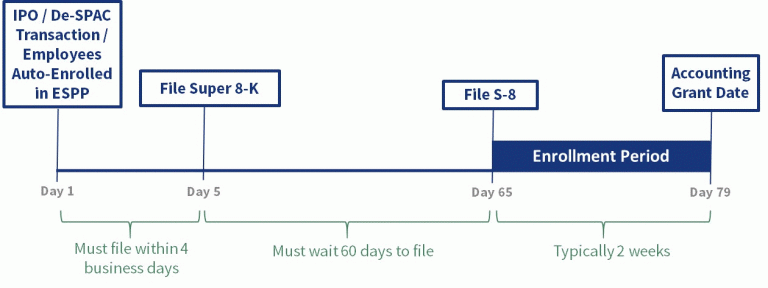A unique opportunity to ensure an ongoing ownership culture.
2021 has been a banner year for IPOs, and particularly for companies going public via a special-purpose acquisition company (“SPAC”). Expectations were high coming into the year, as companies prolonged the decision to go public during the pandemic, but have dramatically bounced back. This, coupled with a new focus on corporate social responsibility, has led companies to develop compensation philosophies that are financially inclusive at all levels of the workforce. Employee stock purchase plans (“ESPPs”) at IPO are an effective way to ensure the IPO excitement is felt by your essential broad-based workers and establish a culture of ownership for years to come.
The Pre-IPO vs. Post-IPO Divide
The period before going public is a unique time in the life cycle of a company, particularly with regards to employee ownership culture. There is a lot of excitement at the prospect of liquidity and potential for meaningful gains for employees with equity in the company, which is often more widespread than their public counterparts. All this works in favor for building a meaningful ownership mentality.
However, this can also lead to challenges sustaining it post-IPO for numerous reasons:
- A divide can be created between new hires that may not receive equity or miss out on larger gains realized by the early employees.
- Turnover among early employees who realize big gains may occur.
- The grants post-IPO may be smaller or given to fewer employees.
- Shareholder constraints placed on public companies may result in a smaller share pool.
Enter the ESPP
ESPPs allow substantially all employees to purchase shares of company stock through payroll deductions, often at a discount, along with other valuable features. Most plans in the US are tax qualified with a maximum discount of 15% while non-qualified plans can offer more generous discounts or matching percentages. The benefits to both employees and employers make these plans very attractive and can be particularly effective if adopted upon or soon after an IPO. Further, these broad-based plans incur lower compensation expense, utilize fewer shares, and result in longer share retention compared to their stock option or restricted share counterparts because employees have a fair amount of “skin in the game” through their own contributions.
Implementing an ESPP at IPO can allow participants to lock in the IPO price for purchases up to as long as 27 months. The excitement of the IPO can also fuel high participation rates from the outset, which can often be sustained for years due to employee “word of mouth” promotion of the program. Strong participation rates will help develop and maintain an ownership mentality with current and future employees long after the excitement of the IPO is a distant memory.
Defining Objectives
The primary design features of an ESPP can be combined in multiple ways to tailor the program to best meet a company’s goals. A company seeking to maximize employee benefits to have the highest possible participation will design a plan differently than a company wanting to balance the benefits with the cost. Therefore, a company should first determine a few key goals and priorities before digging into the details of design decisions. A recent survey from Deloitte[1] showed the primary consideration in structuring an ESPP was evenly split with 38% of respondents indicating “Plan Costs vs. Benefits” and 38% choosing “Achieving a high level of participation”. “Tax considerations” and “Ease of administration and management” scored much lower at 11% and 14%, respectively.
Key Design Features
| Plan Feature | Prevalence [2] [3] | Key Considerations |
|---|---|---|
| Qualified or Non-Qualified | • Approximately 79% of ESPPs are qualified in the US. • For companies that offer ESPP to non-US employees, about half offer a non-qualified plan in those countries. | • Qualified plans have long been attractive in the US given the preferred tax treatment for participants, particularly that there is no taxable event until the shares are sold. However, there are limits to the plan design, as well as additional reporting requirements. • Non-qualified plans differ primarily in two ways: they provide greater flexibility in design and they are taxed similarly to non-qualified stock options. • Companies with international employees frequently offer non-qualified sub-plans outside of the US, so a non-qualified plan in all countries may support global harmonization and unity. |
| Discount or Match | • Qualified plans: 70% offer a 15% discount and 17% offer a 5% discount. • Non-qualified plans: approximately 43% offer a discount and 23% offer a match. | • Most qualified plans are designed to drive participation, thus utilizing the maximum allowable discount of 15%. The next most prevalent discount is 5%, with many of those companies opting for a “safe harbor” plan design that is non-compensatory. • Non-qualified plans can offer a matching program instead of a discount (20% Discount = 25% Match). The simpler design can be easier for employees to understand and appreciate, thus driving participation. • High discounts and matches have been shown to be the number one driver of higher participation and contributions which will increase compensation cost and share usage. |
| Look-Back | • Qualified plans: 62% have a look-back. • Non-qualified plans: 35% have a look-back. | • A look-back feature is attractive to participants since it can yield significant gains in an up market. • The look-back will drive higher participation rates, which increase the expense and share usage; compensation expense per dollar contributed can be as much as 2x a plan without the feature. |
| Length of Offering and Purchase Periods | • Qualified plans: 49% of offerings are 6 months and 25% are 3 months. • Non-qualified plans: 12% of offerings are 6 months, 21% are 3 months, and 14% are 1 month. | • The majority of qualified plans have 3- or 6-month offering periods with coinciding purchase periods, while non-qualified plans tend to be shorter with 1-, 3-, or 6-month offering and purchase periods. • Non-compensatory programs (5% or no discount) tend to offer more frequent purchases to allow for dollar cost averaging. • Qualified plans with 12- or 24-month offerings and multiple 6-month purchases and a look-back to the beginning of the offering period are known as “Cadillac” plans because they provide the maximum possible benefit to participants and drive the highest participation. |
| Eligible Compensation | • Salary / base wages only: ~50% • Full cash compensation: ~45% | • Eligible compensation includes base salary and can also include bonuses, commissions, overtime, and shift differentials. • The types of compensation to include will depend on a company’s workforce and pay practices. |
| Holding Periods | • Qualified: 14% • Non-qualified: 26% • Commonly one year or less | • Mandatory holding periods are utilized to achieve employee ownership objectives by preventing employees from quickly selling shares after a purchase but will negatively impact participation. • Most employees are not selling shares quickly with 67% of companies reporting employees holding >1 year. • Helps employees meet the holding requirements for preferential tax treatment and result in lower compensation expense. |
| Cashless Participation | • Offering from Carver Edison to make the plan more financially inclusive for participants | • Cashless participation allows employees to contribute a smaller portion of their pay and supplement their contributions with cashless participation funds to achieve a desired contribution level (up to company limits). • Shares are sold to repay cashless participation funds, allowing employees to own more net shares than they otherwise could have afforded. • This feature can drive participation and help employees create wealth, particularly for lower paid employees. • The increase in participation and contributions will incur additional compensation cost and share usage to the company, but it is offset by increased cashflow and tax savings along with the benefits of increased employee engagement, satisfaction, and retention. |
Considerations for Driving High Participation
Launching an ESPP at IPO is a unique timing opportunity to drive high and sustainable participation. The following are additional important considerations.
Communication
A robust communications strategy is key for driving participation regardless of the final design. A company can achieve high participation rates even with a 10% discount, a holding period, or without a look-back if they effectively promote the program and its benefits to employees. A communication strategy should focus on educating employees, illustrating the key plan features, and providing timely information throughout the lifecycle of the program from enrollment to purchase to eventual sale of stock. This should be repetitive and produced in a variety of mediums to reach the largest audience.
Locking in the IPO Price
Launching an ESPP at IPO to lock in the initial offering price requires extra planning, but is well worth the effort. The primary challenge is that companies cannot begin the enrollment period before the S-8 is filed and the shares are registered which follows the IPO. While a typical enrollment period precedes the offering period and employees opt in to the plan, an offering at IPO will have an enrollment period that begins at the same time as the offering period. Some employers choose to automatically enroll employees at a set contribution level (which can be 0%), then give employees a limited window to make changes or withdraw from the plan (typically, 2 weeks). Automatic enrollment will lock in the offering price and will encourage virtually every single employee to participate.
Special SPAC Considerations
For a company going public via a SPAC, they must first file a Super 8-K within 4 business days and then wait at least 60 days to file the S-8. This means that the enrollment period cannot begin until at least 64 days after IPO. While the timeline is longer, it is still possible to utilize the above approach of automatic enrollment to lock in the IPO price, but the company has to wait longer to begin the enrollment period, communicate with employees, and begin deducting payroll contributions. See the timeline below as an illustration of key dates for an ESPP implementation following a SPAC.

Note that whether the IPO is traditional or via a SPAC, the accounting grant date does not occur until the end of the enrollment period, which can significantly impact the grant date fair value. Compensation expense may be higher or lower than it would otherwise be depending on how the stock price moves after the IPO. The longer the period between the IPO date and the enrollment date, the more opportunity there is for a greater difference in the stock prices.
Share Reserve and Evergreen
Shareholder approval for ESPPs is very straightforward for public companies; however, private companies are usually able to start with a multi-year reserve and include an evergreen provision which automatically replenishes shares each year based on a defined formula (e.g., 1% of outstanding shares). Once publicly traded, certain institutional investors and certain proxy advisors will automatically vote against a plan with an evergreen provision.
Gaining shareholder approval prior to IPO is still preferable even if the ESPP will not be launched initially. The ESPP can be implemented for up to one year following approval. The company can choose a start date that makes the most sense for their timeline and program objectives.
Other Considerations
The plan document should be drafted as broad as possible, allowing a company to maintain the flexibility to make changes to future offerings within the limits of the plan without going back to shareholders for a reapproval. Qualified plans should include the maximum allowable provisions, even if the initial approach is more restrictive. In addition, the plan should delegate authority to an administrator who can make changes to an offering based on company needs. Above all else, decisions should reflect a company’s goals for their ESPP, but leave room for flexibility to adapt for future changes in objectives.
Conclusion
An IPO is an especially unique and exciting time to be part of a company and to experience its potential growth. An ESPP is an extremely effective program to promote share ownership and engagement with a company, especially as public companies will likely face cost and share constraints in the future. If introduced at IPO, an ESPP can capitalize on the overall excitement and carry that forward for years to come.
A deliberate Pre-IPO approach to align plan design with goals, in coordination with shareholder and stakeholder approval, can result in the most efficient and successful ESPP for a company’s unique circumstances and desired objectives.
[1] 2018 global employee stock purchase plan trends survey.
[2] 2020 NASPP Domestic Stock Plan Survey.
[3] 2018 NASPP Global Equity Incentives Survey.



